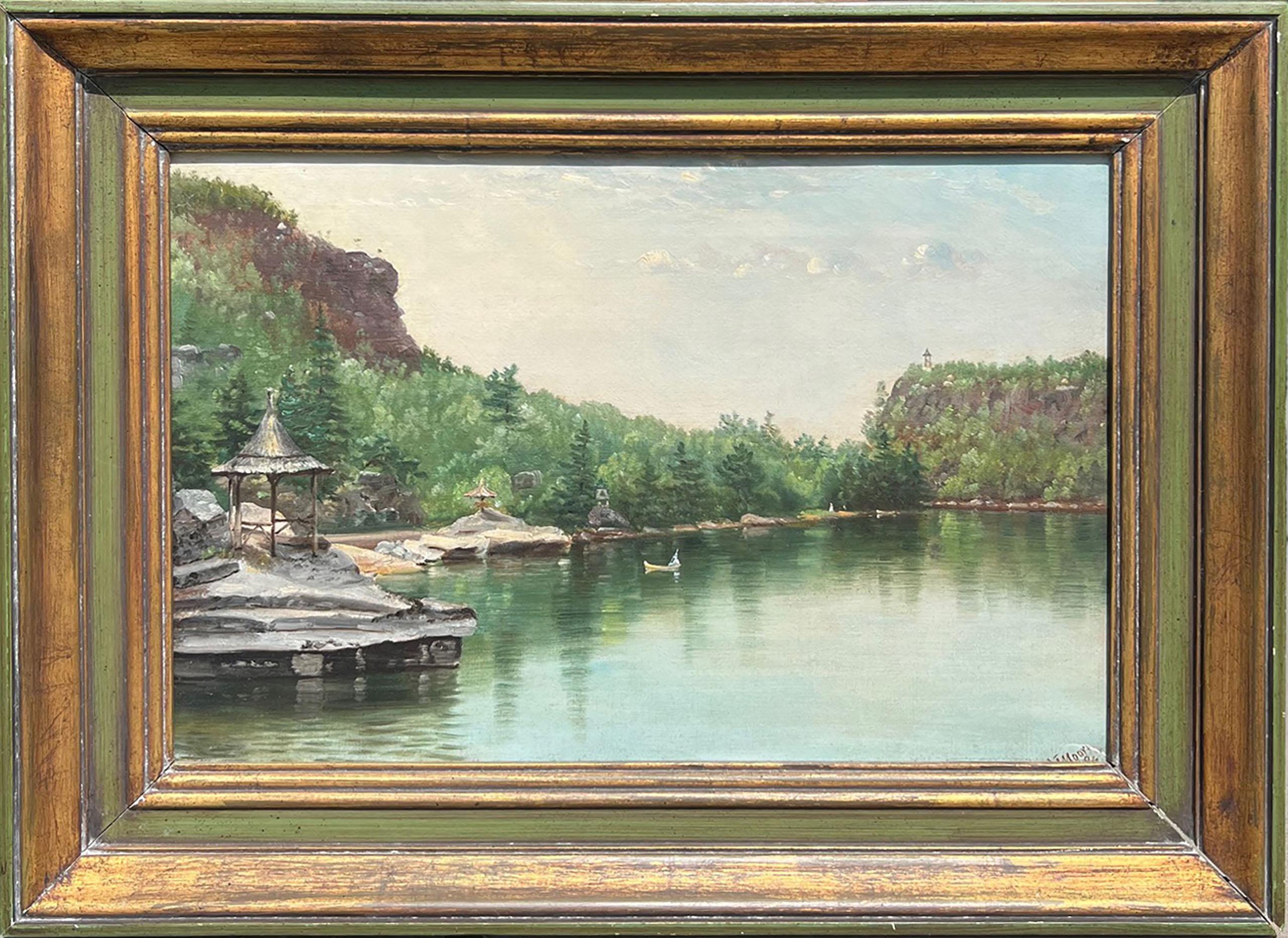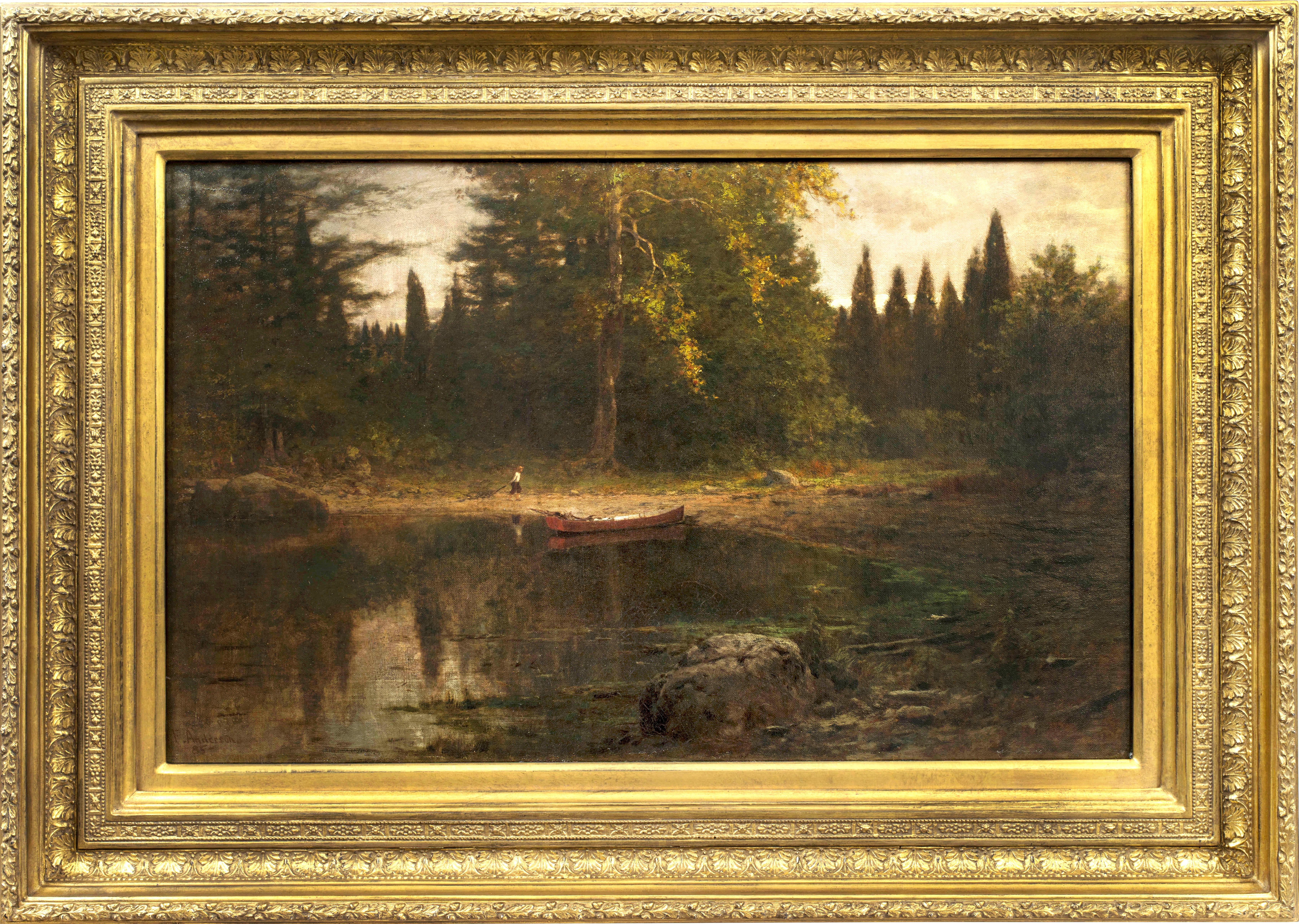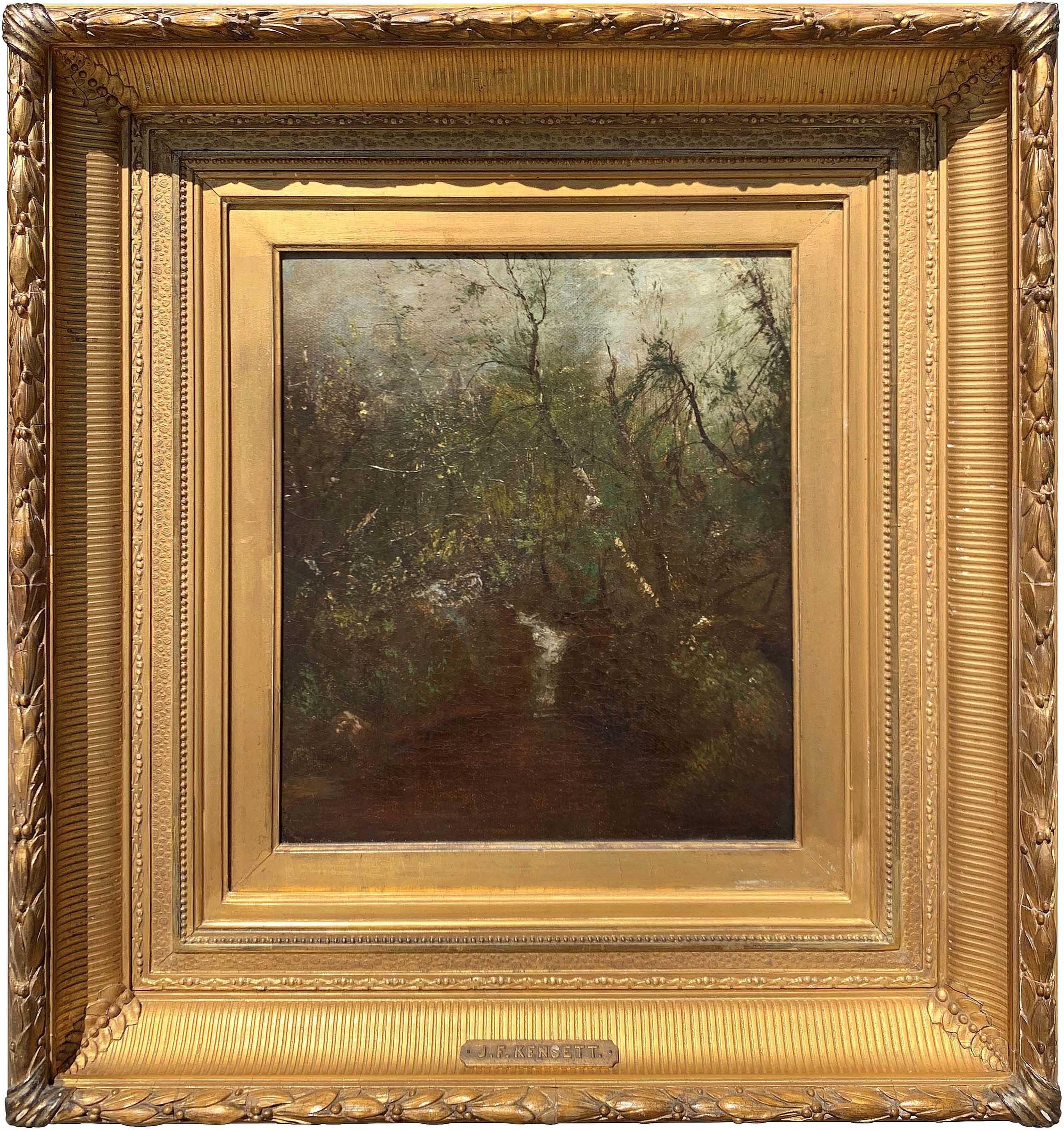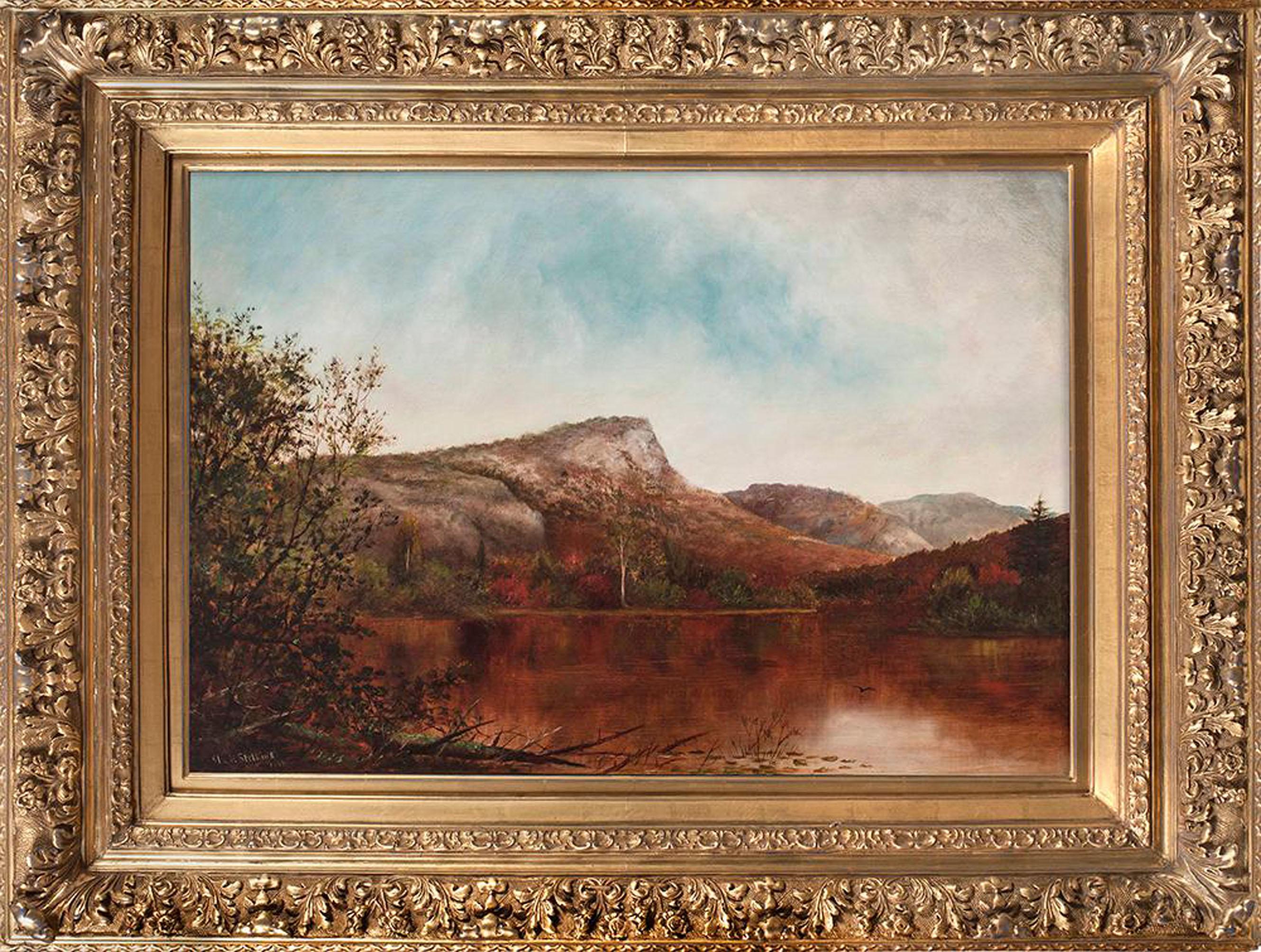Items Similar to "North Conway Farm, " Edward Hill, White Mountain School Antique Landscape View
Want more images or videos?
Request additional images or videos from the seller
1 of 9
Edward Hill"North Conway Farm, " Edward Hill, White Mountain School Antique Landscape View
About the Item
Edward Hill (1843 - 1923)
Haying at a North Conway Farm with Mount Washington in the Distance, New Hampshire
Oil on canvas
13 1/2 x 20 1/2 inches
Signed lower right
Provenance:
Private Collection, Dallas, Texas
Born in Wolverhampton, England in 1843, Edward Hill was the ninth of ten children. Though ultimately less well known than his older brother Thomas Hill (1829-1908), Edward was a productive painter in oil and watercolor for more than sixty years, producing images of the White Mountains of New Hampshire, southern genre scenes, still-life paintings, portraits, American Indian pictures, and western views.
His paintings are widely collected and are represented in museums as diverse as the Hood Museum at Dartmouth College, Isabella Stewart Gardner Museum in Boston, and the Denver Art Museum.
The Hill family moved to Taunton, Massachusetts less than a year after Edward's birth. With his brother Thomas, Edward worked as a furniture painter with firms in Massachusetts for several years, and he shared Thomas' studio in San Francisco in 1862-63 and again in 1872. Edward would be a constant traveler throughout his long career, shuttling for various lengths of time not only between New England and California, but to regions from the American South to the Pacific Northwest.
By the early 1880s Hill's financial success and artistic reputation were well established, largely on the strength of his paintings of the White Mountains. Ever restless and in search of new imagery, however, he also lived and worked at times in Colorado, Utah, and elsewhere in the Southwest throughout the last two decades of the century and the first decade of the next. From 1911 to his death in 1923, the artist lived and painted primarily in the Pacific Northwest.
Hill's paintings are diverse in character, in response both to the changing landscapes he experienced and to the changing influences of the artistic times. Lighter, brighter, and slightly more impressionistic in his later career, his canvases remained topographically accurate, and he was unusually receptive among the landscape painters of his day to inclusion of specific human activities in his work.
- Creator:Edward Hill (1843-1923, American)
- Dimensions:Height: 16.5 in (41.91 cm)Width: 23.5 in (59.69 cm)
- Medium:
- Movement & Style:
- Period:
- Condition:Lined and with one small patch.
- Gallery Location:New York, NY
- Reference Number:1stDibs: LU184129906402
About the Seller
5.0
Platinum Seller
These expertly vetted sellers are 1stDibs' most experienced sellers and are rated highest by our customers.
Established in 2021
1stDibs seller since 2022
59 sales on 1stDibs
Typical response time: <1 hour
- ShippingRetrieving quote...Ships From: Larchmont, NY
- Return PolicyA return for this item may be initiated within 3 days of delivery.
More From This SellerView All
- "Pastoral Landscape, " William Hart, Hudson River School, Cloudy View with CowsBy William HartLocated in New York, NYWilliam Hart (1823 - 1894) Pastoral Landscape, 1877 Oil on canvas 9 1/2 x 14 1/2 inches Signed and dated lower left Born in Paisley, Scotland, William Ha...Category
1870s Hudson River School Landscape Paintings
MaterialsCanvas, Oil
- "Grand Manan" Harrison Bird Brown, Maine Landscape, Hudson River School SeascapeBy Harrison Bird BrownLocated in New York, NYHarrison Bird Brown (1831 - 1915) Grand Manan Oil on canvas 12 x 20 inches Signed with initials lower left Harrison Bird Brown was born in 1831 in Portland, Maine, and is best known for his White Mountain landscapes and marine paintings of Maine's Casco Bay...Category
Late 19th Century Hudson River School Landscape Paintings
MaterialsCanvas, Oil
- "Grand Manan Island Cliffs, Maine, " Marie Medora Ross, Ships at Sunset SeascapeLocated in New York, NYMarie Medora E. Ross (1844 - 1920) Grand Manan Island Cliffs, 1881 Signed Lower Left Oil on canvas 30 x 38 inches Provenance: The artist Gifted to artis...Category
1880s Hudson River School Landscape Paintings
MaterialsCanvas, Oil
- "Building the Allegheny Railroad, Pennsylvania" Alfred Wall, Scalp Level SchoolLocated in New York, NYAlfred S. Wall (American, 1825-1896) Untitled (Building the Railroad), 1859 Oil on canvas 14 1/2 x 18 1/2 inches Signed and dated lower left For Christmas, 2008, the Pittsburgh Post-Gazette featured Alfred Wall's painting, Old Saw Mill from the collection of the Westmoreland Museum of American Art in Greensburg, PA. It was painted in 1851 in the town of Lilly, Pennsylvania in the Allegheny Mountains. The newspaper description stated that "though the saw mill is long gone, it still conveys all the warmth and coziness of this time of year. The article, written by Patricia Lowry, continued: At first glance, Alfred S. Wall's painting of a saw mill in snowy woods triggers nostalgia for the coziness of a log cabin, the smell of a wood-burning fire and the warming of chilled hands and feet beside it. But as sentimental as it seems on the surface, Mr. Wall's painting has a deeper and unexpected context. This is more than a painting about sled-riding children and early industry planted in the middle of virgin forest. Intended or not, this is a painting about conquering the great divide of the Allegheny Mountains. For the third consecutive year, the Post-Gazette features a winter-scene painting on the cover of the Christmas Day newspaper. This year's painting, Old Saw Mill, was selected by co-publisher and editor-in-chief John Robinson Block and executive editor David Shribman during a visit to the Westmoreland Museum of American Art in Greensburg. Mr. Wall, listed as a portrait painter in the 1850 census, was about 26 when he painted Old Saw Mill in 1851. The self-taught artist was born in Mount Pleasant, Westmoreland County, to William and Lucy Wall, who'd emigrated from England around 1820. An artistic sensibility ran in the family: William was a sculptor who carved ornate tombstones here; Alfred's children, A. Bryan and Bessie, were landscape painters, as was Alfred's older brother, William Coventry Wall. For more than a century the Walls formed a prominent art dynasty in Pittsburgh, and Alfred, eventually a partner in the city's most prestigious art gallery, was well known as a painter, dealer and restorer. In Old Saw Mill, two wood cutters, each holding an axe, meet outside the mill; one points in the direction of the forest. On the other side of the stream, one child pulls another down the hillside on a sled. Just behind the hill's slope, the roof of a building appears, perhaps the home of the sawyer. The luminous, late afternoon light comes from the northwest, casting lengthening shadows on the snow under a darkening sky. The saw mill in "Old Saw Mill" likely would have been impossible to track down had Mr. Wall, presumably, not written on the back of the painting: "old saw mill near Jct. 4, Portage RR, Pa." "There was no Junction 4," said Mike Garcia, park ranger at the Allegheny Portage Railroad National Historic Site, about 90 miles east of Pittsburgh near Gallitzen, Cambria County. "But there was an Inclined Plane No. 4 at Lilly, and there was a saw mill there." In fact, there were at least six saw mills at Lilly over the years, said longtime resident Jim Salony, president of the Lilly-Washington Historical Society. But when he saw an image of the painting, Mr. Salony had no trouble coming up with a location. While there are no known photographs of the saw mill, he believes it stood near the intersection of Portage and Washington streets, next to Bear Rock Run. Mr. Salony, retired academic dean at Mount Aloysius College, didn't know exactly when the mill was torn down, but it's been gone since at least the late 1800s. He was pleased to learn of the painting, even though that knowledge came too late for inclusion in a new book about Lilly, The Spirit of a Community, for which he served as primary author and editor. It runs to more than 700 pages. For a little town -- population 869 last year -- Lilly has a lot of history. Nestled in a bowl on the western slope of the Allegheny Mountains about 3 miles south of Cresson, Lilly was first settled in 1806 by Joseph Meyer and his family, who named their 332-acre land patent Dundee. Although the Meyers had left by 1811, other settlers followed, but the community didn't flourish until the 1830s, when the Allegheny Portage Railroad began its 23-year-run through the town. For 200 years the Alleghenies had stood as an impediment to trade and travel between Pittsburgh and the east. A canal from Philadelphia to Pittsburgh would change that and compete with New York's Erie Canal. But a portage railroad would have to be built, on which teams of horses would lead the canal boats over the mountains. Engineer Sylvester Welch began his surveying from the small settlement at Lilly. The railroad would require 10 inclined planes, some quite steep, between Hollidaysburg and Johnstown. To build it, trees had to be cut along a 120-foot-wide right-of-way for 36 miles, along which track and engine houses had to be built. William Brown, who owned the saw mill on Bear Rock Run, built at least one of the engine houses at Inclined Plane No. 4; an 1834 contract also included fencing the dwelling lots at the head and foot of the plane. Lilly is located at what was the foot of Inclined Plane No. 4., giving the community one of its early informal names, Foot of Four. Named in 1883 for Richard Lilly, who'd completed the grist mill there, Lilly had another early name: Hemlock, so dubbed by a Portage Railroad traveler who smelled the bark stripped from the trees at the saw mill. Because there isn't another Allegheny Portage Railroad location like it, where a cut in the mountains opens into a bowl, Mr. Salony thinks it was Lilly that Charles Dickens wrote about following his trip from Harrisburg to Pittsburgh on the Pennsylvania Canal in late March 1842, describing what he saw after emerging from "the bottom of the cut": "It was very pretty while traveling, to look down into a valley full of light and softness, catching glimpses through the tree-tops of scattered cabins; children running to the doors; dogs bursting out to bark, who we could see without hearing; terrified pigs scampering homeward; families sitting out in their rude gardens; cows gazing upward with a stupid indifference; men in their shirt-sleeves looking on at their unfinished houses, planning out to-morrow's work; and we riding onward, high above them, like a whirlwind." To get to Lilly, Mr. Wall may have taken the Pennsylvania Canal from his home in Allegheny City, now the North Side. He'd married young, at 21, to Sarah Carr in 1846, the same year he began his career as an artist. By 1880 they were living in a brick townhouse at 104 (later 814) Arch St., now demolished. Across the river in Pittsburgh he shared a studio at 67 Fourth Ave. with his brother William; they later moved to Burke's Building, today the city's oldest office building at 209-211 Fourth. But often they worked outdoors, sometimes as part of the colony of artists that grew up around painter George Hetzel beginning in the late 1860s at Scalp Level...Category
1850s Hudson River School Landscape Paintings
MaterialsCanvas, Oil
- "Couple in the Field, " James Brade Sword, Hunter on Farm LandscapeBy James Brade SwordLocated in New York, NYJames Brade Sword (1839 - 1915) Couple in the Field Oil on canvas 16 x 20 inches Signed lower left After a childhood in Macao, China, James Brade Sword started out in life, after hi...Category
Late 19th Century Hudson River School Landscape Paintings
MaterialsCanvas, Oil
- "Ship Portrait, " William Edward Norton, Seascape Maritime Painting, New EnglandBy William Edward NortonLocated in New York, NYWilliam Edward Norton (1843 - 1916) Ship Portrait, 1876 Oil on canvas 10 x 16 inches Signed and dated lower left Born in Boston, William Norton became a noted marine painter, stirred by his youth when he sailed on family-owned ships. He studied at the Lowell Institute in Boston, and with George Inness, and then established a studio in Boston. In the early 1870s, he went to Paris and became a student with Chevreuse and A. Vollon, and then he settled in London where he exhibited throughout the last quarter of the 19th century. His reputation there was based on his scenes of the Thames River, and ocean and coastal views. In 1901, he and his wife returned to the United States and settled in New York City. He also painted at Monhegan Island, Maine, where a treacherous ledge on the southern side of the island is named "Norton's Ledge" for him. He was a member of the Boston Art Club with whom he exhibited from 1873 to 1909. He also exhibited with the Pennsylvania Academy, the Royal Academy in London, the Paris Salon, the 1893 Chicago Exposition...Category
1870s Hudson River School Landscape Paintings
MaterialsCanvas, Oil
You May Also Like
- Lake Mohonk by Hudson River Artist Nelson Augustus Moore (American, 1824-1902)By Nelson Augustus MooreLocated in New York, NYA rare depiction of Lake Mohonk, this painting by Hudson River School artist Nelson Augustus Moore (1824-1902) features Sky Top Tower and the serene natural surroundings of the historic Mohonk Mountain House. This 19th century oil painting on canvas measures 12 x 17.75 inches. The painting is signed and dated at the lower right, signed again and titled "Lake Mohonk" on the verso. The painting is framed is ready to hang. Nelson Augustus Moore was born on August 2, 1824, in Kensington, CT. His artistic studies began under the tutelage of Thomas Cummings and Daniel Huntington in New York City. After returning home to Connecticut, Moore taught drawing classes and also opened a photography business. He and his brother operated this daguerreotype studio in Hartford, CT until 1864 when Moore chose to return to landscape painting. His landscapes consisted mostly of New England subjects. He kept a studio in New York, painting in the same building as Arthur Fitzwilliam Tait, James Hart and William Hart. Nelson Augustus Moore, while sharing in many ideologies with his contemporaries, felt no need to travel vast distances in search of grandiose and spectacular landscapes. He held a particular delight in the peaceful harmony of the local American countryside...Category
19th Century Hudson River School Landscape Paintings
MaterialsCanvas, Oil
- Landscape in the Hudson Valley by Worthington Whittredge (American, 1820-1910)By Worthington WhittredgeLocated in New York, NYHudson River School artist Worthington Whittredge's (1820-1910) Landscape in the Hudson Valley is oil on canvas and measures 11 x 19 inches. The work is signed by the artist at the l...Category
19th Century Hudson River School Landscape Paintings
MaterialsCanvas, Oil
- Hudson River Inlet, 1885 by American artist Frank Anderson (American: 1844-1891)By Frank AndersonLocated in New York, NYHudson River Inlet, 1885 by Hudson River School artist Frank Anderson (1844-1891) is oil on canvas. The work measures 15.13 x 24.25 inches ...Category
19th Century Hudson River School Landscape Paintings
MaterialsCanvas, Oil
- Meadow and Mountain at Sunset by Andrew Melrose (Scottish-American, 1836-1901)By Andrew MelroseLocated in New York, NYHudson River School painter Andrew Melrose's (1836-1901) "Meadow and Mountain at Sunset" is oil on canvas and measures 12 x 18 inches. The painting is signed by Melrose at the lower left. The work is framed in and ready to hang. Little is known about the early life of Scottish-born artist Andrew Melrose, though available literature often notes that he was largely self-taught. He is thought to have come to America in 1856, stopping in New York before moving on to Toronto. Within ten years, Melrose, along with his wife, had relocated to the New York area. His first great success came in 1867 when he was commissioned by the Chicago and Northwestern...Category
19th Century Hudson River School Landscape Paintings
MaterialsCanvas, Oil
- Woodland Waterfall by John Frederick Kensett (American: 1816-1872)By John Frederick KensettLocated in New York, NYJOHN FREDERICK KENSETT (1816-1872) Woodland Waterfall Oil on canvas 14 x 12 inches Signed lower rightCategory
19th Century Hudson River School Landscape Paintings
MaterialsCanvas, Oil
- View of South Pond, New York, 1879 by Ida H. Stebbins (American, b. 1851)Located in New York, NYPainted by Hudson River School artist Ida H. Stebbins (b. 1851), "View of South Pond, New York," 1879 is oil on canvas, measures 23 x 33 1/2 inches, and is signed and dated 1879 at t...Category
19th Century Hudson River School Landscape Paintings
MaterialsOil, Canvas
Recently Viewed
View AllMore Ways To Browse
School Antiques
Antique Mountains
Antique New England Art
Hudson Used Furniture
Antique Boston
Used Furniture Mountain View
Brother Thomas
Used Children School Furniture
Southern Pacific
Brown And White Antique Paintings
Washington Antiques
Antique Indian Painting Paintings
Antique Indian Painting
Antique Indian Paintings
Antique Painting Indian
Boston Art Painted Furniture
Antique Colorado
Colorado Antique





